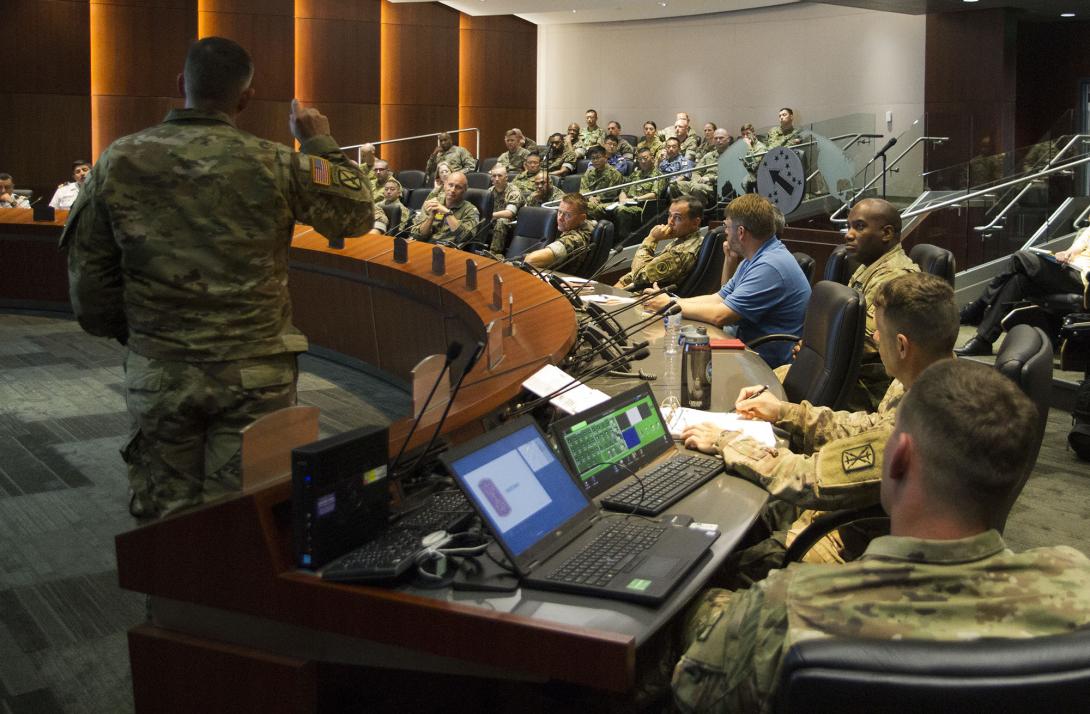Every Shooter Is an IT Sensor
One of the foundational tenets of warfare is understanding the enemy and environment. The same can be said for information technology (IT) service delivery, IT service management and cybersecurity, in which the enemy can be a combination of actors, actions and threat surfaces.
Furthermore, the environment can be three- and four-dimensional depending on the enemy action and intent. And just as maneuver warfare utilizes an array of human and technological sensors to identify, close with and engage enemy forces, so too must IT service delivery and management, integrated with cybersecurity, employ similar methodologies for success. In essence, every “shooter” (customer/user) must also be an IT sensor capable of informing and relaying environmental threat conditions to IT and cybersecurity technicians and managers.
The transition from layered domain operations to multidomain operations and the advent of Joint All-Domain Command and Control (JADC2) foster IT service delivery and cybersecurity challenges that must be integrated and effects-based. Furthermore, discrimination between multidomain operations and operating in multiple domains is critical for shared understanding and effective capability employment. Strictly speaking, operating in multiple domains is merely the means and execution of layering activities across the domain spectrum, whereas multidomain operations is the convergence created by the concerted employment and integration of offensive and defensive capabilities from multiple domains that terminate a set of effects against enemy targets. Consequently, as information networks and technologies are converged and integrated across multiple domains and disciplines, the ability to reduce the ever-expanding threat surfaces, identifying and negating enemy actions and activities while continuing to enable effective mission command are critical to force readiness and deployment.
Two influential technologies provide opportunities to radically change IT service delivery, management and cybersecurity practices by reducing the threat surface and recognizing nefarious actor actions among the clutter of traditional IT service outages. Additionally, applying predictive analysis toward IT system challenges fosters improved service delivery and management across tactical and operational domains. Here, the transition to cloud-computing capabilities, coupled with artificial intelligence (AI) virtual agents and predictive and generative analysis, sets the stage for increasing the sensor base while improving cybersecurity postures and streamlining IT service delivery processes and practices. Recently, Christine Wormuth, secretary of the Army, noted, “We certainly are looking for how we can leverage AI to make our capabilities—both new and under development—more effective.”
Rapid deployment and adoption of cloud computing technologies enable the transition from a hardware-centric environment into a software and data-centric environment. Furthermore, use of cloud computing enables integration of disparate networks and data sources while reducing IT cost models across the enterprise. Implementing variations of cloud computing service delivery models, such as software as a service and infrastructure as a service, reduces the need for expensive licensing agreements and physical racks of hardware spread over multiple locations and customer bases. For example, hosting database services in a cloud environment reduces physical hardware costs across multiple entities and transitions users into a data-centric-based operating model, while empowering more robust cybersecurity measures. Finally, the integration of platforms as a service enables IT service delivery personnel to create customized applications and business delivery processes while obviating the need for expensive support infrastructure.
The transition to a data-centric environment is critical for mission success across all military services. The Army Digital Transformation Plan (2021) sets the stage for the strategic alignment of cloud technologies coupled with the unifying efforts for the Army’s IT enterprise. Furthermore, technical architecture development and deployment must include cybersecurity and cyber hygiene tenets to mitigate adversarial activity while promoting tactical and operational use. These concepts can be seen in the Army’s contribution to JADC2 and Project Convergence, which seeks to link shooters and sensors throughout the network. Consequently, data and technical architecture integration serve as the foundational cornerstone enabling effective decision-making and efficient mission execution.
Just as multidomain operations converge and integrate capabilities, cloud-computing technologies cannot be implemented in a vacuum. The use of AI virtual agents and generative analysis elevates the effects created through the synergies of each technology area. Here, one can truly enable every “shooter [customer]” to act as a sensor, cybersecurity tripwire and feedback mechanism to improve IT service delivery. The use of virtual agents would allow the customer to autonomously provide feedback on IT service delivery anomalies or outages all the while building data sets for both short- and longer-term predictive analysis. This feedback mechanism creates positive organizational change, further extends cybersecurity postures and allows rapidity in IT service delivery methodologies.
Simultaneously, integrating both AI predictive and generative analysis facilitates the transition to a data-centric environment, enabling IT service delivery organizations to anticipate and mitigate potential IT issues before they occur. Maj. Gen. Christopher Eubank, commanding general at the Army’s Network Enterprise Technology Command (NETCOM), noted during AFCEA’s TechNet in Augusta, Georgia, that “Data is the new ammo … we have to organize it; we need to be able to see it visually.” Additionally, Lt. Gen. Maria Gervais, deputy commanding general and chief of staff at the U.S. Army’s Training and Doctrine Command, highlighted how AI and cloud capabilities can significantly improve how data and information are processed and analyzed, thereby increasing agility and lethality of kinetic and nonkinetic weapons systems. AI predictive analysis underpins the visual representation and serves as the building blocks to reduce complexity at the user level. It reduces manually intensive activities and streamlines cybersecurity awareness and adversarial mitigation strategies.
Not meant to endorse or promote a specific framework or methodology, the ITIL Service Framework provides an established and useful framework to overlay the technology. Within the service design and service strategy processes, generative AI platforms can facilitate capacity and availability management by integrating management databases and programs to enable predictive methodologies for maintaining service standards and customer parameters. Additionally, generative AI tools and platforms can be used to better engage with stakeholders in developing and synthesizing unique mission requirements into the IT support infrastructure. Furthermore, generative AI tools allow for the ingestion and integration of disparate data sources, such as text or imagery, into readily usable formats for supporting service strategy functions relative to portfolio management, financial management and return on investment analysis.
Transitioning to service operations, generative and predictive AI underpins the “every shooter is a sensor” concept. Employing generative AI platforms facilitates a more humanistic approach to service desk operations than current portal menu interfaces. Here, generative AI can be used to create a more encompassing approach during the initial outage reporting processes, thereby allowing IT technicians to focus on complex troubleshooting and IT maintenance tasks vice customer interaction. For example, the AI platform would replace a portal-driven menu drop-down approach with a more conversational and platform-agnostic interaction, allowing for two-way feedback and problem identification. Moreover, generative AI is not limited by traditional business hour models. The tool or platform operates 24/7, thus allowing customers to engage and report IT system outages or anomalies throughout any operational cycle.

Within the policy and compliance domain, generative and predictive AI can be instrumental in summarization and thematic search across multiple documents, data sources and inputs, allowing for expedited review and analysis. Here, generative AI can aid cybersecurity defender personnel in rapidly reviewing eMASS or cyber scorecard inputs, focusing on key data sets, identifying vulnerabilities or gaps in threat coverage and supporting the development and employment of cybersecurity countermeasures to reduce the threat surface. Finally, AI tools allow for scenario planning and predictive analysis of actions or events that may impact mission success.
Notwithstanding the technological potential of AI and cloud computing, the people aspect of capability integration and execution must be addressed. Individual preferences and biases interact with organizational culture and behavior mores to influence IT artifact use and employment. This influence can be positive and/or negative depending on the type, level and complexity of the technology implementation. Within the workspace, a social system is created in which change can be viewed as a threat or a reward and, in this context, individual and group status, autonomy and certainty can be challenged when significant technological capabilities are suddenly deployed. Consequently, new technology and associated processes require both an emotional and rational methodology for employee engagement and decision-making.
The Army Data Plan (2022) highlights the challenges noted above and offers new paradigms of leadership and organizational application. Through the integration of digital transformation and personnel development, technological insertion capability can be maximized while minimizing cultural resistance and adoption. Increased transparency and inclusiveness in planning and execution phases significantly mediate emotional responses and hesitation for adoption. Former Chief of Staff of the Army Gen. James McConville noted the Army must first learn how to use data and then how to use data more effectively: “I’ll admit, we haven’t quite figured [predictive logistics] out yet. We really do need everybody’s help to think through that problem.” Finally, strategic messaging across all echelons of command facilitates a deeper understanding of both new technology insertion and the change processes required for deployment success.
Achieving excellence in multidomain operations will require careful balancing of current and emerging capabilities with technological transformations designed to enable commanders and decision-makers at all levels to “make the right choice, at the right time, and achieve the right effects.” Or, as Gen. McConville highlighted, AI can help soldiers and civilians sort through data to get the “right arrow ... in the Army’s proverbial quiver.” This balancing must also expand the operational and tactical sensor range to successfully integrate capabilities and data sets necessary for predictive analysis and data-driven decision-making. Convergence of cloud computing technologies with AI, therefore, serves as a springboard to the next level of operational and tactical excellence.
Dr. James E. Cronkhite is the civilian executive officer (chief of staff) for the 106th Signal Brigade resident within the 7th Signal Command (Theater) located at Fort Sam Houston, San Antonio, Texas. He is responsible for ensuring operational and supporting staff activities are prioritized and executed on behalf of the command team and the supported regional network enterprise centers, standalone network enterprise centers, local network enterprise centers, and the 56th Signal Battalion.
The opinions expressed in this article are not to be construed as official or reflecting the views of AFCEA International.





Comments